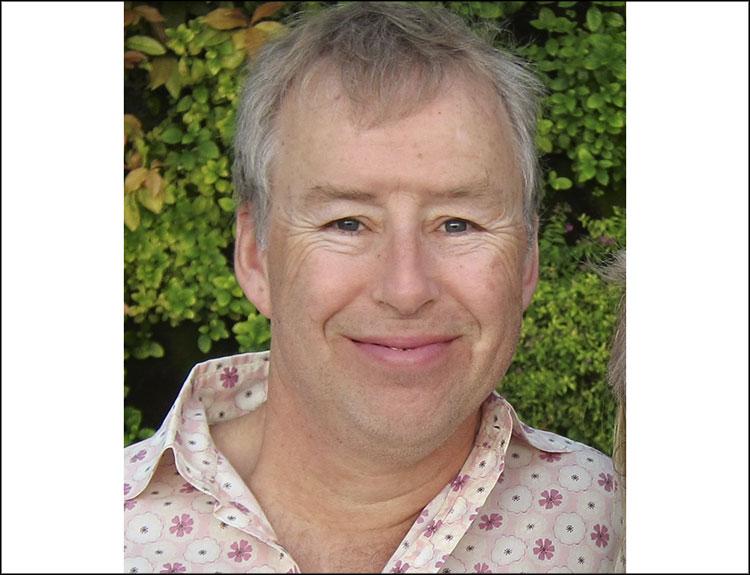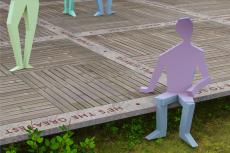Simon Parkes, noted painter, art conservator, adviser, and collector, and longtime East Hampton resident, died on Aug. 20 at the age of 71 after a long illness with cancer.
Mr. Parkes was widely known as the founder and driving force behind Simon Parkes Art Conservation in New York City, where he and his team of conservators evaluated and restored tens of thousands of paintings for the world’s leading collectors, dealers, galleries, and auction houses. Their restoration work included paintings by many of the world’s most important artists, from old masters to works by Picasso, Jean-Michel Basquiat, and Warhol.
But Mr. Parkes was equally recognized as a landscape painter in his own right — of beloved places and their hidden nooks. Based for much of the year in East Hampton, he chose as his subject matter the beautiful locations where he lived and traveled and where the well-to-do like to vacation — Maine, Martha’s Vineyard, the Bahamas, Italy, Spain, England, and the South Fork.
Mr. Parkes’s widely collected paintings “evoke a deep love of nature and of unblemished, refined signs of civilization,” his family wrote, “sandy paths through the brambles and bayberry at Lazy Point, the summer beach scene at Georgica, his own family’s back porch in East Hampton, the cliffs at Shadmoor in Montauk and Cedar point, Wainscott and Sagaponack farmland, boats at anchor off Swan’s Island, Me., where he had a house, olive orchards in Mallorca, the deep green hills of the English countryside.”
“Parkes’s plein air landscapes welcome a dialogue with the natural world and beckon a swift return to familiar haunts,” Angus Wilkie wrote in “Simon Parkes — Summer Places, Eastern Long Island and New England,” published by Vendome Press in 2005.
“I paint feelings, emotional memories, smells, temperature, and sounds . . . I try to garner an emotional response, which I hope is deeper than simple place recognition,” Mr. Parkes reflected in a 2009 interview with Fine Art Today.
He came somewhat late to painting, conceding in various interviews that he developed his talent with the brush and palette — he worked exclusively in oils — through his restoration work.
Working in the style of and inspired by the plein-air painters of the 19th century, such as John Constable and William Merritt Chase, Mr. Parkes painted his first landscape in the late 1980s when he was in his late 30s. But painting became a daily practice, “his true love, his meditation, his church,” his widow, Jane Parkes, said recently.
When not running his art conservation business in New York City, Mr. Parkes would disappear in any weather in search of a setting where he would spend hours at his easel. He would go on to produce hundreds of paintings and be the subject of several solo exhibitions at the W.M. Brady and Co. gallery in New York, among other galleries.
“Alone with the ticks in the sun or the rain, I feel as if the world freezes for me in an instant,” he told Mr. Wilkie.
He was born to Matthew Donald Parkes and the former Lorna Eirene Holland on March 4, 1954, at Wellington College in Berkshire, England, where his father was a mathematics teacher and a dorm master. Mr. Parkes grew up in the British public school system. Sent to boarding school at the age of 7, to Eagle House, and then on to Wellington and then Clifton College, he rebelled and was thrown out at 15 for sneaking out to a Led Zeppelin concert.
Recently widowed and at a loss as to how to raise his seemingly wayward son, Mr. Parkes’s father sent him to London to live with his brother Colin where the teenager landed a job sweeping the floors, making tea, and playing Ping-Pong with the noted British restorers, the brothers Hume, Derek and Roger. It was there that he began his restoration apprenticeship.
Once proficient, the young Mr. Parkes moved to New York City with his first wife, Aelise Epps, whose family lived in New York. The marriage didn’t last, but the move to America sparked his career.
He took a job in the paintings department at William Doyle Galleries, which connected him to everyone in the trade — not only collectors and dealers, but truckers, art handlers, the pickers (as they are called), the experts in all departments of the auction business.
“He did not discriminate,” his wife remembered. “He was friendly to everyone, and everyone liked him.”
Mr. Parkes’s charm, Home Counties British accent and congenial manner promised success, but it was his sharp eye as an art adviser and condition evaluator that would prove his greatest asset. He delivered his advice on the condition of paintings without favor or fear — “straight, honest, and sometimes . . . often actually, it could be disappointing,” his wife said. He both saved and earned for his clients, and steadily built relationships and trust in the art world.
“He gave me and my family excellent advice and I regarded him as a good friend,” Matthew Green, an art dealer, recalled recently, echoing the sentiment of many in the art world. “It was never too much for him to give me his valuable time.”
Mr. Parkes’s sharp eye also netted him the money to break out on his own. In the 1980s while working at William Doyle, he alerted the Metropolitan Museum of Art to what he believed to be an oil sketch by Jean-Baptiste-Camille Corot, a study for a larger, important work by the 19th-century French artist. The museum sent experts, but ultimately passed. Mr. Parkes bought it for himself at auction and later sold it to a prestigious dealer. Shortly afterward, the Met reconsidered and purchased the little painting. It now hangs at the museum beside Corot’s masterwork, “Hagar in the Wilderness,” for which it served as a study. Mr. Parkes’s profit from this stroke of intuition helped finance the opening of his own restoration studio.
He opened his conservation business in 1985 in two small rooms above the Graham Gallery, hiring a few restorer friends. Business grew exponentially, to the point where Simon Parkes Art Conservation and its many conservators became one of the largest, if not the busiest, in America. Operating on 74th Street, around the corner from Sotheby’s, Mr. Parkes’s studio serves painting departments, dealers, and galleries around the world including Sotheby’s, Christie’s, the David Zwirner Gallery, Alex Katz studio, Marlborough Galleries, Bonhams, Doyle, among many others.
In a note about her former boss and colleague, the painter and restorer Karen Schifano, who was Mr. Parkes’s longest-running employee, reflected that he “taught me everything I know about painting and restoration, about what made something art (or not) through his enthusiasm, obsession even, with seeing and knowing what made a painting ‘work.’ ”
“Less is more” was Mr. Parkes’s mantra as a restorer. The “ultimate client,” he explained to The Wall Street Journal in 2011, is “posterity,” in other words, loyalty to the painting, the painter, and the work in its original form.
“The vigilance in this business is to be true to the painting. Not the auction house, or dealer, or owner. What’s right for the picture, not for the mood” of the current times, Mr. Parkes said.
He is survived by his wife of 42 years, the artist Jane Parkes, their two sons, Homer Durand Parkes of Los Angeles and Haley Ingersoll Parkes of Queens, and their respective spouses, Ray and Theodora, a granddaughter, Desert, his brothers Colin Boyd Parkes and Robert Christian Parkes, both of the United Kingdom, and a sister, Susan Eirene Parkes of Mallorca and London. A fourth sibling, Andrew Parkes, died in 1960.
He lived in New York City, East Hampton, and Swan’s Island.
A memorial service is being planned in New York City for later this fall.




